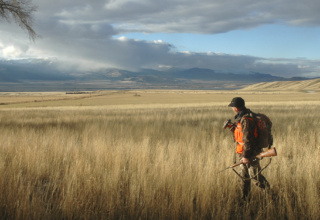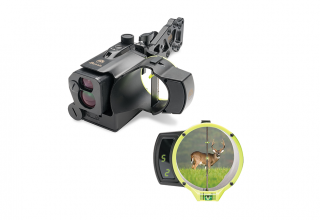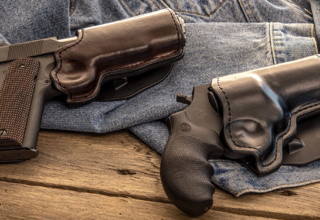We don’t believe in hyperbolic, over-the-top headlines at Shoot On, but Scent Thief technology is something YOU MUST TRY this hunting season
by Rob Reaser
When I was a young hunter, around 10 or 11 years old, my father worked for one of the top archery distributors at the time. The company ran a pro shop and had invited bowhunting legend Fred Bear to come for a public meet-and-greet. During the Q&A session, I was standing beside my childhood hero (number 2 only to my Dad!) when someone in the audience asked Mr. Bear what he thought about cover scents. His answer has stuck with me for over 40 years.
Fred Bear said he didn’t really believe in them and explained why. I think he was talking about one of his Kodiak bear hunts in Alaska. Fred and his hunting companions had come across a bear that was muzzle-deep in a carcass, eating away at a large pile of rotting flesh and innards of something. The wind shifted and the bear suddenly raised its head and turned to look at them. Mr. Bear said that if an animal could smell a whiff of human from that distance and through the overwhelming stench of that decaying pile of whatever it was, he felt that no one stood much of a chance of hiding his scent from a whitetail.
That notion has held much truth in my hunting experience and that of most attentive hunters. Try as we might to reduce or eliminate our scent through diligent use of scent management products and strategies, the fact remains that 100-percent of human scent can never be eliminated in the field short of hunting in a Level A HAZMAT suit.
Heretofore, there have been two primary scent-management strategies hunters employ, the first being scent reduction or mitigation and the second being scent cover up. Sure, there are sub-strategies involved, but all fall under one of the two categories.
Scent reduction leverages various chemical technologies to suppress or alter scents that can be alarming to game animals—specifically human scent. These products are intended to change the composition of scent molecules to eliminate their smell. This covers most scent elimination sprays as well as ozone-based products.
Cover scent is used by itself or in conjunction with a scent reduction technology. The concept here is to introduce a strong, natural odor (such as animal urine or a plant-based aroma such as pine, apple, or earth) to help mask existing human scent or to overwhelm an animal’s nose so that human scent is less noticeable.
These two approaches to scent management are all we’ve ever known, and retail shelves are chock full of products to meet the ultimate objective: keep deer from smelling you before you can execute a clean, ethical shot.
Well, today there is something new. Totally new. It’s called Scent Thief.
As we just described, scent management has, historically, focused on scent origins (that would be us) or, to be more precise, reducing or covering up human scent to make it harder (but not impossible) for game animals to smell us. Scent Thief is a patented technology that works in the opposite direction, in a manner of speaking. It works on the scent “receiver” instead of the source of the smell.
As to how it works, the company describes it best: “Scent Thief temporarily relaxes the olfactory epithelium in both humans and animals. The olfactory epithelium is a specialized epithelial tissue inside the nasal cavity that is involved in smell. It lies on the roof of the nasal cavity above and behind the nostrils. The olfactory epithelium is the part of the olfactory system directly responsible for detecting odors. With the olfactory epithelium relaxed, an animal can no longer detect odors of any kind.”
So, while traditional scent control strategies either attempt to suppress odor by changing scent molecules or by attempting to mask or dilute human scent with an overwhelmingly more powerful scent, Scent Thief simply prevents an animal’s ability to detect odors by working on the tissue inside the nasal cavity that controls the ability to smell.
That’s neat.
Since the company claims the product affects the sense of smell in humans and other animals (assumably any critter with olfactory epithelium tissue), I decided to test it on myself. Granted, our ability smell is downright pathetic compared to that of big game animals, but I figured that if it worked with me, it just might perform as the manufacturer claims.
Poking around the house, I hit the kitchen and grabbed a piece of paper towel and a bottle of rather potent malt vinegar. I saturated the paper towel with the malt vinegar and smelled it for potency. Yep…it had some wang to it. Next, I applied a couple squirts of Scent Thief to the saturated paper towel and took a big sniff. I could not smell the malt vinegar at all—not a trace. The only odor I could detect was that of the Scent Thief.
Scent Thief has an aroma that’s hard to describe. To my nose, it’s somewhat like Pine-Sol cleaner or an astringent pine scent with hints of wet earth and a subtle waft of anise (black licorice). I asked my wife to take a snort full to see what her impressions were. She said it definitely has a pine note with a healthy heap of “earth.”
Moving on, I went to my workshop and repeated the process by saturating a piece of paper towel with Hoppe’s #9 gun solvent. Powerful stuff. The result was the same. One squirt of Scent Thief onto the paper towel and that was all I could smell.
Okay…time to kick it up a notch. For my next trick, I rummaged through my box of hunting scents and pulled out a two-year-old bottle of synthetic coon urine—a concoction strong enough to make your eyes water. Again, I saturated a piece of paper towel with the foul stench but this time I spayed Scent Thief on a separate piece of paper towel. Holding the coon urine scent directly behind the Scent Thief, I walked with the paper towel piece held in front of my nose to simulate the odor blowing on a breeze. Once more, the nose-hair-curling coon urine was not to be detected. I could only smell the Scent Thief.
On a lark, I pulled a stem from one of my tomato plants and crushed it. Tomato plants have a rather strong and distinct odor, so I tested it against Scent Thief. I held the crushed plant between my fingers, placed the nozzle of the Scent Thief bottle in front of the smushed plant material and faced the breeze. Same result.
My conclusion—from the human nose perspective, Scent Thief works to prevent humans from smelling any odor other than the Scent Thief aroma. Is it affecting the function of the olfactory epithelium? I have no way of knowing exactly what’s happening up my snout. All I can testify to is that it absolutely does something to prevent smelling anything but Scent Thief.
A couple weeks ago, one of our Shoot On staff was bowhunting elk in Wyoming and using Scent Thief for the first time. If you’ve ever hunted elk, you know that they have some of the best noses in the game animal world. In shifting currents, he managed to get within 22 yards of a nice bull elk without being detected. Unfortunately, a tangle with his bow and a dry branch quickly turned a lay-up shot into the missed opportunity of a lifetime. So goes hunting, but it proved the efficacy of Scent Thief on the King of the Mountain.
Because humans have such a poor sense of smell, scent elimination products are something we cannot evaluate with our own noses. As our opening anecdote from the legendary Fred Bear himself reveals, even scattered, diluted molecules of human odor can be detected through the diverse and often substantial odors in the natural world. In short, we can never entirely eliminate our scent no matter the strategy. Most of you likely know this first-hand. Scent Thief, however, changes the math by working on the scent receiver as opposed to the scent source.
We’ll continue to use the product throughout this hunting season to give it a much broader evaluation, but our initial impression is that Scent Thief truly has changed the hunting game in our favor. Wind direction, for example, may no longer be a factor in where we place or approach our stands, or whether we can hunt a particular area because of the wind. That will open a lot of opportunities otherwise denied us.
Scent Thief offers their special formulation in several forms—all with a 100% money-back guarantee. The all-important Field Spray comes in 24-oz. bottles and a 32-oz. refill. Also available is a Scent Thief Wafer, which is convenient for hanging beside you on your stand so that whichever direction the wind blows your scent, Scent Thief will cover the area.
Additionally, Scent Thief is offered in laundry detergent and body wash/shampoo form. These have the same smell as the wafers and Field Spray and will certainly provide you with A to Z coverage. If you want to try it all, check out the Scent Thief Trophy Pack, which include a 24-oz. Field Spray, wafer, laundry detergent, and body wash/shampoo.
Scent Thief proved itself on our staff elk hunt, so I’m running on high confidence that I’ll experience equally good results when our state’s whitetail archery season opens. The weather will be warm (meaning high sweat potential), so this will be the ultimate test. The product is available in retail stores and through various online merchants, and you can order direct from the manufacturer.
Should Scent Thief prove to work on whitetails as it has proven to work on elk, hunters across the country may truly flip the odds in their favor this hunting season.






















